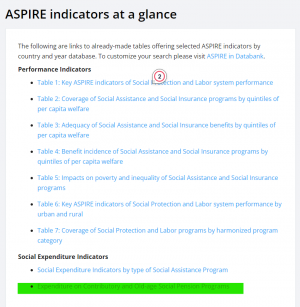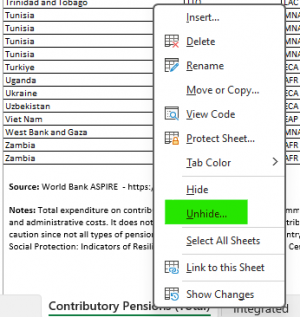ASPIRE Database, World Bank
The Atlas of Social Protection Indicators of Resilience and Equity (ASPIRE) is a database developed by the World Bank to provide detailed information on social protection programs and their impacts around the world. The database aims to support the evaluation and analysis of social protection systems, focusing on their coverage, adequacy, and equity.
Key Milestones and History:
1. Early 2010s - Inception:
The ASPIRE database was developed as part of the World Bank's efforts to monitor and assess social protection systems globally. The initiative arose from the need for a comprehensive, globally comparable source of data on social protection programs, especially those targeting the poor and vulnerable populations.
2. 2013 - Public Launch:
The ASPIRE database was publicly launched around 2013. It brought together data from over 120 countries, combining household surveys and administrative data to measure the performance of social protection programs in terms of poverty reduction and economic resilience.
3. Expansion and Development:
Over time, the ASPIRE database has expanded its scope, incorporating new indicators related to social safety nets, labor markets, pensions, and other social insurance programs. The database continues to evolve with new data, allowing policymakers, researchers, and organizations to track the development and outcomes of social protection systems.
4. Data Coverage and Indicators:
The ASPIRE platform provides users with indicators related to:
- Coverage: How many people are receiving social protection benefits.
- Spending: The amount spent on social protection programs as a percentage of GDP.
- Impact: The effectiveness of programs in reducing poverty and inequality.
- Distribution: How benefits are distributed among different income groups.
It aggregates data from household surveys to offer insights on social assistance, insurance, and labor market programs.
5. Ongoing Updates:
ASPIRE continues to be updated regularly with the latest data from national household surveys and administrative data, making it a valuable tool for understanding how social protection systems are evolving and their impact on poverty and inequality.
6. Global Usage:
Today, ASPIRE is widely used by governments, international organizations, and researchers to design, implement, and evaluate social protection policies and to compare social protection systems across different countries.
The ASPIRE database has become a critical tool in global efforts to address poverty, vulnerability, and inequality through social protection mechanisms. It allows for the assessment of resilience and equity in countries' social protection systems, contributing to more effective policy-making and intervention strategies.
Currently, we have 1 preprocessors in IFsHistSeries, GovtPension%GDP.
Instructions on Importing data
- Go to https://www.worldbank.org/en/data/datatopics/aspire/indicator-glance
- Click "Expenditure on Contributory and Old-age Social Pension Programs" to download the data.
- Open the downloaded file. Right-click on the tab. Choose "Unhide".
- A view will pop up and Select "Integrated Pension Plans" and Click "OK".
- Use the "Integrated Pension Plans" tab to prepare GovtPension%GDP.
Notes
For the most recent update (Oct. 2024), we only have data from 2016-2021. The new data combined with the data in IFsHistSeries.
The sources for the data in IFsHistSeries are
- International Patterns of Pension Provision by Palacios and Pallares-Miralles, 2000;
- OECD Social Expenditure Database. World Bank Pensions Performance Indicators Q2, 2013;
- 2015 data update provided by Devin D'Angelo in communication with MTI. From https://www.imf.org/en/Publications/FM/Issues/2018/10/04/fiscal-monitor-october-2018.


